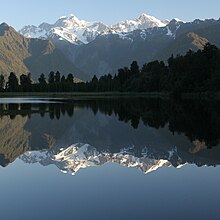Appearance
Westland Tai Poutini National Park is part of a UNESCO World Heritage Site known as Te Wahipounamu in South West New Zealand. The national park lies on the West Coast of the South Island in the Southern Alps, adjacent to Aoraki / Mount Cook National Park and to the north of Mount Aspiring National Park.
Understand
[edit]History
[edit]Landscape
[edit]Flora and fauna
[edit]Climate
[edit]The area is very rainy. Parts of the park can receive up to 11 metres of rain in a year.
Settlements
[edit]
The following settlements lie close to the park:
See
[edit]
- Franz Josef Glacier - Perhaps the most accessible glacier in the southern hemisphere. At one stage it was possible to drive right up to the terminal face. However, the glacier is receding, so you must walk to the foot of the glacier.
- Fox Glacier - Not quite as spectacular as the Franz Josef Glacier but not crowded with tourists either.
- Lake Matheson - Tall mountains reflected in a mirror calm lake - sometimes - but a perfect postcard image when it happens.
- Mount Cook and the other mountains - from the western side.
Do
[edit]Hike
[edit]A large number of hiking trails have been created in Westland Tai Poutini National Park. Detailed maps are available from DOC visitor centres at Franz Josef and Fox Glacier, where you can also get tickets for overnight stays in the park huts, hunting permits and souvenirs.
- At Franz-Josef Glacier
- The Douglas Walk is a small circular route over the glacial moraines, leading through different vegetation zones that document how nature is reclaiming the areas of the melted glacier. The trail passes the Douglas Suspension Bridge, which spans the Waiho River, and Peters Pool, a small lake that beautifully reflects the glacier. You should plan about an hour for the circular route.
- The Roberts Point Track branches off the Douglas Walk. Alternatively, you can also start directly from the village of Franz Josef, but you should plan an additional four hours. The trail leads along the north side of the glacial valley through the rainforest. Suspension bridges, slippery river crossings and galleries provide variety. After 9 km of walking with a 600 metre increase in elevation, you reach the Roberts Point from which you have a beautiful view of the glacier and can watch the helicopters touching down on the ice. Unfortunately you have to descend the same way you came. Allow approximately 5 hours for the hike (from the start of the Douglas Walk).
- Certainly the most challenging trail is the Alex Knob Track. The hiking trail climbs 1000 metres in elevation on the south side of the valley through several vegetation zones up to the Alex Knob. From there you have a panoramic view over the glacier and the surrounding mountains. You should start early in the morning, as unfortunately clouds often gather on the glacier in the afternoon. The trail is 12 kilometres long and takes about 8 hours.
- At Fox Glacier
- The Chalet Lookout is a historical lookout point of the lower part of the glacier and the surrounding mountains. A hiking trail slowly ascends from the end of Glacier View Road. The trail is 4 km long; allow 90 minutes.
- The Mount Fox Track is much more demanding. The trail begins off State Highway 6 a short distance south after the Glacier View Road turnoff. It goes steeply uphill past the tree line. Again and again there are fantastic views over the coast, the glacier and the New Zealand Alps. You should start early, as clouds often block the view of the glacier and the mountains in the afternoon. You should allow 8 hours for the hike.
Other
[edit]- Sightseeing flights in a helicopter over the glacier
- Guided tours over the glacier

